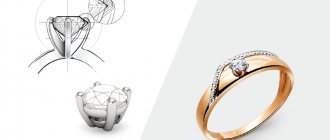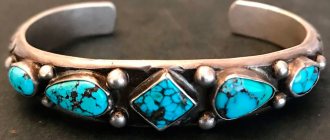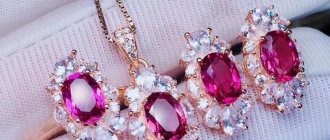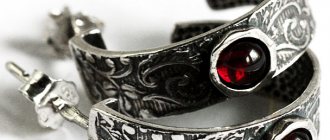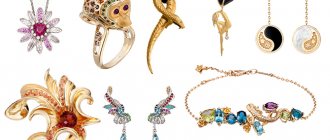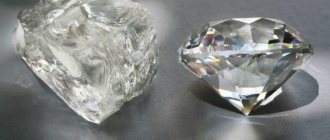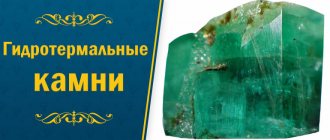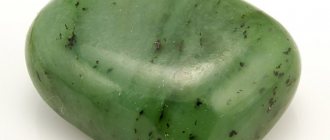Setting is the way in which a gemstone has been “set” into a piece of jewelry. Not only the reliability of fixing the insert depends on the type of setting: it can be used to advantageously present the stone or hide its defects, make the diamond float above the rim or securely wrap it in metal - to protect the beauty during daily wear. We'll tell you all the secrets of setting stones in jewelry!
The model is wearing white gold rings with diamonds 921644-1B, mesh ring 921657B, patterned ring with diamonds 921652-2B and engagement ring 921643B. The cost of each is in the link.
Blind setting of stones
A blind setting is the same as a blind cast or socket setting. It is also called rim or Bezel. The stone here is securely surrounded by a metal band (cup), or placed in a bezel setting, with only the top visible - as in this engagement ring with a small diamond. Advantages of deaf casting:
- practicality - does not catch hair and clothes;
- reliability - the insert will definitely not be lost;
- safety – the risks of damage and chipping of the diamond are minimized;
- benefit - blind casting does not require high quality parameters of the diamond.
The disadvantage of a blind frame is that the rays of light cannot penetrate the entire depth of the precious mineral. To improve the play of the insert, use a blind double-sided setting of a transparent stone - a drawer frame. In this case, the metal hugs the perimeter of the stone, but it is open at the top and bottom, as in this ring with round marquise cut diamonds.
Ring with marquise cut diamonds 931367B (solid setting)
Where is blind setting used?
Speaking of rings, solid caste is used to set opaque stones in rings - like this Palace exclusive with mother-of-pearl. A solid set with an open bottom is an excellent choice for rings that will be worn daily. The applicability of the deaf cast depends, incl. from its variety, and there are many of them.
- Gypsy setting is a type of socket setting where the stone is placed flush into a recess and secured by rolling metal over the insert, as in an octagonal engagement ring with 8 diamonds.
- Flash setting is great for setting small round diamonds. The seat is drilled into the bezel, the insert is pressed tightly in, and then secured with a barely noticeable gold belt - the stones glow beautifully, hence the name flash. The ring flashes with diamond sparkles - just like in this engagement model.
- Cretonne frame - the insert is held in place by a strip of metal, usually openwork. Not a very reliable type of fixation, used for inexpensive rings with large inserts of semi-precious stones.
Despite the reliability of the blind caste, check its quality when purchasing to see if the insert in it is loose. Diamond jewelry rarely suffers from this, but inexpensive silver jewelry often suffers from this.
To main§ 39. Setting stones
Setting in jewelry technology is the process of securing stones into a frame or socket of a finished product. The essence of setting is to prepare (process) a socket according to the shape and size of the stone, securely fasten the stone in the product and process the frame or socket so that the product is not only beautiful, but also comfortable. It is not difficult to imagine the consequences of a poorly set stone - loss stone, irritation of areas of the body in contact with the tenon of the stone, constant snagging of the frame on clothing and other objects that are in friction with the product, etc. A qualified and high-quality fastened product helps to see the stone and the entire product from the best side. There are three main types of setting - prong, blind and fadan-grisant (Fig. 111). Prong setting is a setting in which the stone is held in a setting using prongs—separate posts. When setting blind, or crimping, the stone is clamped on all sides by a setting (crimping) belt of caste, continuous around the entire perimeter. With fadan-grisant setting, the stone is inserted into the product and clamped there with corners raised by a metal tichel and lightly heaped onto the crown of the stone.
Each type of fastening has its own characteristics. Thus, the prong setting gives the product lightness and delicacy. The stone that is most open on all sides not only retains its shape and cut without distortion for viewing, but also enhances the game due to the entry of a large amount of light. Products with prong-set stones are convenient because the stones in these products are easy to wash, and periodic washing of the stones to remove plaque and restore their play is mandatory. With a blind setting, the stone is securely held in the setting by a beautifully designed grisant (grained) belt. A blind setting makes it possible to give the stone a more regular shape, emphasizes the contrast of the color of the stone and metal in products with painted gems, and mirror trimming on white metal (platinum, white gold, silver) around the diamond seems to increase its size. When using products with solid stone settings, the possibility of the frame catching on clothing is excluded. Fadan-grisant setting - an abundance of stones in combination with intermediate corners - gives the product a special charm. The mirror cutting between the stones and the grisant pattern bordering them give the impression of a fusion of stones in the pattern. Each type of setting involves several operations and requires a different approach to them depending on the shape and number of stones, so the set of tools and accessories is very diverse. Tools for setting stones include more than a dozen items. These are gravers, hand-held wooden vices, kittstocks, crimps , corner cutters, corner cutters, needle files, polishers, jewelry drill, drill bits, etc. Stichels
(Fig. 112) - cutters used to cut out sockets for planting stones, press the stone into the socket, process and cut products. All cutting blades are made from steel grades U12D or HVG with mandatory hardening. The blade, or rod, of the gravel, the length of which is 100 - 120 mm, is inserted into a mushroom-shaped wooden handle. The upper part of the blade is called the back, the lower part is called the blade.
Blade angle is the angle between the side edges (sides) of the blade. The inclined frontal area obtained as a result of sharpening is called the sharpening area, and the angle formed between the blade and the sharpening area is called the sharpening angle. The working end of the sharpie on the back side has an arched cutout, which allows you to reduce the sharpening angle. The cutting edge is a rib formed by the sharpening area with the sides and the blade at an acute angle. The cutting blades of each type are divided by numbers, which determine the thickness of the back, and therefore the angle of the blade. All cutting blades must have a well-polished blade and wall that forms the cutting edge. Sharpen the gravers on fine-grained whetstones 50 X 150 X 170 mm, lubricated with machine oil. Sharpening is done from the back of the gravel at the required angle of the graver to the stone; it is desirable that the sharpening area is formed in one sharpening step. The walls and blades of the gravers are polished on marble blocks and leather rubbed with polishing paste (GOI). The gravers are inserted into pre-drilled holes (2 - 3 mm) of the handles to a depth of 2/3 of their length. The length of the handles of the cutting gravers is from 30 to 70 mm, depending on the change in the length of the blade during the sharpening process; the length of the handles is 40 - 45 mm. The diameter of the neck is 10 - 12 mm, the cap is 30 - 35 mm. The neck of the handle is reinforced with a metal ring that protects the handle from splitting. The lower part of the cap folds, the formed plane makes it possible to better fix the position of the gravel during operation and grip the handle more tightly in the palm of your hand. The shape and sharpening of the gravers of each type correspond to their purpose. In Fig. 113 shows the main profiles of cutting blades and methods for sharpening them.
Spitzstihel
- one of the most common cutting gravers, it has a wedge-shaped shape with convex sides.
Spitztichel blade angle is 30 - 45°, optimal sharpening angle is 45°. It can have straight and lateral (right and left) sharpening. With a straight line, the sharpening area forms an acute angle only with the blade, thus, the cutting edge will be angular and the graver will perform rough cutting with fadan-grisant setting and double-sided cleaning. The pin with side sharpening performs adjustment functions (internal side trimming). When sharpening on the right, the sharpening area forms an acute angle not only with the blade, but also on the right side (from the back; side. In this case, the cutting edge will be the right side of the blade. The angle of convergence of the sharpening area with the right side will be the angle of the cutting edge, its range is 45 - 60°. The left sharpening differs from the right one in that the cutting edge, formed by an acute angle, is located on the left side. Spitz sharpening tools with side sharpening are used for inserting stones for fadan-grisant setting and into castes, for finishing castes and fadan-grisant cutting , cleaning up corners, etc. The blade of the gravel is lightly ground (filled) on the block. The number of the gravel and the height of the working part of the blade are chosen depending on the nature of the work and the size of the stones. To fit large stones, the blade is ground more than usual. Ballistic
- a gravel with a rounded blade , regardless of the cross-sectional shape of the blade.Ballsteel can have vertical and inclined (straight and convex) side walls, depending on how the rounding should be.
The fixing radius of the fastening pins ranges from 0.2 to 1.0 mm. Sharpening angle 45 - 60°. They are used in fadan-grisant setting to raise the metal into a stroke (stump) on which a corner is rolled. The size of the corner depends on the radius of curvature of the blade and the sharpening angle of the sharpener: the larger the radius of curvature and sharpening angle, the thicker the raised corner. This is a very important operation that requires good hardening of the working end of the gravel. When installing a corner, more force is applied than with a simple cut; when overheating the serger, its cutting edge immediately breaks off, and if the hardening is insufficient, it becomes crushed - and the serger can break off, breaking the corner. Ballstichel is used for cutting and cleaning the grooved areas of the product. Messerstichel
- has a wedge-shaped cross-section and a sharp blade.
The blade angle, depending on the number, is from 15 to 30°. The sharpening angle of the graver is about 60°, the height of the working part is 3 - 4 mm, with lower sharpening the end becomes “liquid”. Messerstichel is used to clean up spaces between roots and other hard-to-reach areas. Flachstikhel
- for any shape of the blade section it must have a flat blade.
The shape of the flagstick can be rectangular (with steep sides), trapezoidal (with a small and large base of the blade). Depending on the purpose, the blade width ranges from 0.2 to 4.0 mm. A special feature of the pen sharpeners is that the height of the working end is left no more than 2.0 mm, this makes the tool convenient to use and facilitates sharpening. Narrow flagstones are used for finishing trimming fadan-grisant setting, trimming corners and for other purposes; wide - for finishing castes and cutting all types of settings for glossy trimming. Davchik
(Fig. 114) is a type of shtikhel. This is a rod inserted into a mushroom-shaped handle. Pressors differ in shape and surface of the working platform. The press for prong fastening is made of steel, its working part has a platform with a groove cut. The working part of the crusher, which serves to clamp the stone with narrow valves, is not hardened. To clamp thick prongs and the walls of a thick-walled blind caste, a shoe press is used, the working platform of which has a fine notch. Thin-walled castes are clamped with a boot press with a smooth, non-hardened working platform. The same pressure is used to level the shape of the caste around the entire perimeter. In cases where it is necessary to preserve the shape of the prong, the surface of the wall of a blind caste, or when there is a danger of stone chipping when the hammer comes into contact with a stone (for placing small stones into a nest), copper hammers are used - boot type and with a round platform.
Hand wooden vice
- used to secure stones in a product.
Screw vices are predominantly used. The length of the vice is 100 - 120 mm, the divergence of the jaws is up to 15 mm. The cross-sectional shape of the vice jaws is semicircular, with a diameter of 30 - 35 mm. In a vice, stones are secured into rings, the design of which can withstand pressure from gravers, cutting, crimping and other tools. Kittstock
(Fig. 115) is a cylindrical wooden handle with a head for oiling jewelry to be set on it. Handle length 90 - 100 mm, diameter 30 - 35 mm. The shape and dimensions of the head are chosen depending on the type and size of the product. The head of the kittstock is covered with a thick layer of special paste - kitta, which rigidly fixes the product in the desired position.
When heated, kitt - a mixture of rosin with ground chalk or tooth powder - softens and fills the cavities and spaces of the product, and when cooled, it hardens and allows great force to be applied when setting stones and cutting the product without fear of deforming the product. (For preparation of kitta, see § 16). Kitstocks are used to strengthen not only products that can become deformed, but also products that, due to their design features, cannot be secured in a vice.
Crimpers (crimping punches)
— designed for pressing round stones in remote castes. The crimping punch (Fig. 116) is a steel (hardened) rod with a conical recess inside, which is inserted into a mushroom-shaped handle. The taper of the recesses (the angle of convergence of the walls) is 45 - 60°, the diameters of the holes are different with a transition of 0.2 mm. For ease of crimping, the crimp also has an external taper, the angle of which is set depending on the diameter of the rod. Crimping punches can be single-sided or double-sided. Single-sided ones have a crimp cone on one side, and a shank on the other for securing the crimp in the collet holder of the handle. For double-sided ones, crimp cones are located on both sides, and the rod is inserted into the handle with the non-working (currently) side, for which a metal nozzle with a hole and a fastening bolt is made in the handle. The handles of the crimpers do not have a cut, like the handles of the squeezers, and can be made of both wood and various plastics. The working cone of the swaging must have a well-polished surface, without burrs, nicks or burrs.
Kornovertki
(Fig. 117) are steel rods with a spherical recess at the working (end) end. Rod length 60 - 70 mm, diameter 2.5 - 4.0 mm. The diameters of the spherical recesses are from 0.2 to 1.0 mm, in rare cases up to 1.5 mm, the depth is 1/3 of the diameter of the sphere. Corners are used to give a raised metal bar (stump) a spherical head - a corner. The working end of the curler must be hardened and well polished, the other end - the shank - is inserted into a mushroom-shaped (without cutting the cap) handle. Kornovertki are made from steels: “silver”, U8 - U12. 8 In most cases, corner-turners are made by jewelers themselves from 3-4 mm “silver” or from the rods of used needle files. The process of making them is not complicated, but it requires skill and great care. First, in the center, on the well-sawed ends of the rods, dimples are made to 1/3 of the depth, using a special matrix, which has a set of protruding spikes with spherical or rounded polished heads. Then the working end of the rod is given an external taper without touching the walls of the recess, and, in order to avoid oxidation, it is subjected to hardening. Heated during hardening in a fused borax medium. After hardening, if necessary, the working recesses are polished with GOI paste or diamond paste. If the handles have the same outer diameter, then for the entire set it is enough to have one handle with a metal attachment that has a hole adjusted to the diameter of the handle.
Corners
(Fig. 118) - like cornrollers, they have a working part with a spherical depression, sawed off from the sides until a groove is formed. The diameter of the root recesses is from 0.2 to 0.6 mm with a depth equal to 1/3 of the diameter. Corners are made from the same materials as corners, but the blanks for them are flat or round with a flat-forged (flat-sawed) working end. Usually they are made from fragments (60 - 70 mm long) of a flat semicircular or equally convex file. The process of making and hardening corners is similar to making corners, but processing the working end is more labor-intensive. The difficulty is that the notch on the sides provides a certain depth of the sphere and groove, and the adjusted width allows the groove to be held on the edge of the product without touching the stone, corners and neighboring ribs. The flat section of the rod, as well as the cut on the mushroom-shaped handle, help to maintain the directional position of the rooter.
Corners are used for applying a grain line - grisant - to the edge, sharply cut with a serviche. Grisant - a grisant notch (knurling) - is made around a stone fixed in a blind caste on the edges of the fadan-grisant cut and on the edges of the openwork top (veins, mesh, etc.). To apply grease, a more productive tool is used - knurling (Fig. 119). The knurling at the end of the rod, inserted into the same handle as the root cutter, has a narrow roller with a linear pitted texture on the edge. Depending on the width of the grainy mark left, knurling is divided by number.
At the fixer's workplace, which does not differ from the assembler's workplace, in addition to the product and the box for laying out the stones, there must be tools and devices necessary for the work. The product is strengthened in a manual wooden vice or on a kittstock. To heat products onto the kittstock, a torch burner is required, over the flame of which the kitt is softened. The kit is heated evenly on all sides, then the product is heated over a flame to 70 - 80°C and it is greased onto the kit in a position convenient for fastening. While the kit has not hardened, it is leveled with tweezers so that its level is below the surface of the product; in places not subject to cutting, the level of the kit is left level, or even above the surface of the product. Inside castes and holes under the stone, the kitt is pressed deeper so that the spike of the stone can freely descend to the desired depth. The kitt remaining on the inner walls is removed. After oiling the kittstock, it is put aside until the kitt is completely hardened. The principle of prong setting is that on the inside of the prongs, at the same level, notches are made on which the stone girdle will rest, and the ends of the prongs, rising above the girdle, are bent onto the crown of the stone. Jewelers determine the level of prongs on prongs visually, which does not mean approximately. The initial data for determining the level are: the height of the prong section that bends (depending on the size of the stone from 0.5 to 1.0 mm), the thickness of the girdle and the depth of the stone tenon (the stone tenon should not extend beyond the lower level of the product). Grinding products are supplied for setting, so the top of the caste is leveled with a file, after which, having outlined the level, the prongs are cut. In most cases, the prongs are covered with a flachstichel and a spitztichel. In castes with a small number of prongs, notches for the stone can be made with a specially sharpened needle file. The prongs are made so that the nest formed by the prongs is vertical and has a cornice as a lower stop (Fig. 120). The stone should fit tightly into the socket and without distortion. After making sure that the stone is in the correct position in the caste, the free ends of the prongs are pressed onto the stone pavilion with a pusher. When clamping the prongs on the stone, follow this sequence - bend the opposite prong next. Having pressed all the prongs tightly, the castes are checked for clearance: if any of the prongs is hanging, they are pressed even tighter. It is advisable that the bent part of the prong rests not on the edge, but on the edge of the stone (especially for round stones), this will deprive the stone of the ability to turn.
In some cases, with thick prongs and hard metal, it is permissible to press the prongs with a fastening hammer (Fig. 121). However, it is completely unacceptable to hit a stone when working with a hammer. For a number of stones, setting with a hammer is generally excluded. These include: opal, emerald, amethyst and other fragile stones. In addition to the fragility of the stones, when setting, other equally important factors should be taken into account, such as the thickness of the girdle, the shape of the cut, and the strength of the stone. Even the “strongest” stones with a thin girdle or sharp corners (when cut with marquise, teardrop, or all rectangular shapes) tend to chip if the setting is not careful enough.
Processing the prongs after setting the stone consists of making them identical in length and shape, and if necessary, polishing or cutting the surface of the prong into a facet (double-sided glossy trim) until an edge is formed. If the hardness of the stone is above 7 (Mohs), the prongs are processed with a small needle file with a polished edge directed towards the stone, in all other cases - with gravers. The process of setting in blind castes also begins with determining the level of setting of the stone. Having determined the level of depth of the socket using the same criteria, it is selected by trimming the walls of the caste with a spitz-sticker (adjusting) with the right side sharpening. First, a shallow belt is selected with a graver at the depth of planting the stone. After making sure that it is at the same level on all sides, the nest is increased in diameter to the size of a stone (Fig. 122). Thus, by adjusting the socket and periodically trying on a stone in it, make sure that the walls of the selected socket are large and vertical. If the socket is chosen with a large undercut, the stone will dangle in the fixed caste. The walls of the cast should remain the same in thickness so that when they are bent, external irregularities or folds do not form. The stone is placed in a tightly fitted socket with light pressure from a finger, a gravel handle or a copper press, depending on the size of the stone, and pressed.
Round stones are compressed using a crimp of the appropriate size; if this is not enough, the belt is pressed with a press. Stones of oval, rectangular and other shapes are pressed using a notched press and then leveled smooth. Thin-walled castes are immediately squeezed with a smooth pressure. The process of pressing with a presser proceeds in a certain sequence - first the stone is pressed from two opposite sides, if no distortion is observed, the stone is pressed from the other two sides. If a skew of the stone is detected and the reason for it is uneven compression or shift, then the stone is leveled by lightly tapping the protruding part of it with the handle of a gravel, finger pressure or a press, and in this position the compression is fixed, and then evenly compressed. When the stone is tightly seated, its uniform compression begins immediately. Particular care must be taken during crimping when working with “weak” stones and with rectangular and other shaped stones with sharp corners. As a result of pressing the stone, the upper part of the wall of the caste falls onto the stone pavilion along the entire perimeter, and on the surface of this section of the caste very often traces of the pressing tool remain. Therefore, the belt is leveled with a fine (worked) file and, if necessary, a polisher. From the side of the stone, the caste along the entire perimeter is cut into a fadan (a one-sided glossy trim that serves as a kind of reflector) until a rib is formed, onto which a grisant notch is applied. The grain size of the grisant is chosen depending on the size of the stone: the smaller the stone, the finer the grisant. Grisant rolling is the final operation of this type of setting. Fadan-grisant tack is the most complex type of tack, associated with cutting the entire tack area of the product with burrs. The setting process begins with the insertion of stones (previously selected) into their holes. Most often, a quotation mark is used for this. They choose a dense vertical nest for the stone. The depth is such that the girdle of the stone is below the surface of the setting area (Fig. 123). For ideally round stones, the socket can be selected using a drill with a sharpening angle less than the angle of the stone tenon, or a conical bur, the cone angle of which is selected according to the angle of the stone tenon. The nest is drilled out either with a hand-held jewelry drill or with a drill (bur) clamped in a collet holder or metal jewelry vise.
The sequence of grazing, as well as cutting, is as follows - they start with large stones and end with small ones.
Having made sure that the stone sits tightly in the nest, proceed to the next operation - setting the corner. To place a corner means to move a stroke with a metal stylus, which is subsequently given the appearance of a ball using a curler. This ball (corner) acts as a prong that holds the stone. The size of the corner, and therefore the number of the ball with which the corner will be raised, depends on the size of the stone, the number of corners and the shape of the area being cut. The essence of this operation is that the stroke is moved with a gravel, which rises above the surface and is moved (pulled) towards the stone, so that the wall of the nest in this place slightly leans onto the edge of the stone pavilion. Having placed all the corners and thereby ensuring that the stone is securely held, they begin cutting. The metal around the stone is trimmed with a glossy sharpie, without touching the corners, creating a kind of reflector, the shape of which depends on the overall cutting pattern. This operation is called "cutting fadan". It must be done carefully so that, firstly, you do not cut off the corner, and secondly, you do not expose the girdle of the stone. Along with trimming the fadan with a narrow flachstikhel or messer-shtikhel, the corners are cleaned, that is, the vertical ribs are cut off with them, and metal is selected between the corners, after which they are given a glossy spherical shape using a cornrower. A grisant notch is applied to the edges of the cut fadan. The grain size of the notch is dictated by the size of the stones, the design and the entire product. The sequence of fadan-grisant setting can be changed if the glass hardness of the stones being set is lower, or the depravity of the stone raises the fear that it will split when touched with a gravel. In these cases, the corners are not placed completely, and the entire cutting is carried out without stones (pre-packed). After finishing the entire setting area, the stones are placed in their places and pressed with corners. Previous page
| table of contents | Next page |
Prong setting of stones
Where are the best diamonds? Of course, in golden paws! When buying a pure diamond with high 4C values, in 95% of cases this type of caste is chosen. The prongs practically do not cover the insert, the stone is open on all sides, creating ideal conditions for its play - and you enjoy the full beauty of a diamond, ruby, sapphire...
Advantages of prong setting:
- presents a diamond or gem favorably;
- visually enlarges the insert, lifting it;
- easy to clean.
Well, the disadvantages include the risks of weakening the prongs. If one or more of the tabs become bent, you risk losing the insert. In addition, bent prongs can catch clothes and hair. Check their condition regularly. The Palace's jewelers, taking care of the safety of the stone, process the prongs with a rhodium plating pencil in order to strengthen them.
Diamond engagement ring 921248B (prong setting)
Where is prong setting used?
The prong setting “grew” from the blind bezel setting, and became popular at the instigation of the founder of the Tiffany jewelry house, Charles Lewis Tiffany. In 1886, he introduced the world to a ring model in which the diamond was raised above the rim by 6 prongs.
Prong setting is a standard method of setting stones in engagement rings. The so-called “princess ring” is a prime example of this. The diamond is raised and is clearly visible from all sides. The number of prongs may vary, but usually there are 4 or 6. The shape and length of the “legs” depend on the imagination of the designers, for example, in models of modern design they can be almost square, as in a model made of red gold.
Faden setting - a variety of prong setting - “legs” grasp two stones at once, expanding at the top.
White gold ring with diamonds 921554B (faden setting)
The main advantages and disadvantages of a gemstone in a setting.
Framing allows you to make it safe when using the product.
In addition, the stone sits tightly in its place and the frame strip gives it stability, preventing it from falling out.
The metal edging protects especially vulnerable edges of the stone, preventing various types of damage.
By using stone surrounds instead of prongs, you do not risk snagging on clothing or other objects. The main disadvantage of edging is that such products have a higher price.
In addition, depending on the height of the facets of the gemstone, the metal frame can cover a significant part of the stone, which can affect the disclosure of all its advantages.
Corner setting of stones
Corner setting of stones in jewelry offers a wide variety of fixation options. What they have in common is the following: the insert is attached directly to the metal, in the hole in the rim, and gold posts or balls (corners) are used to hold it in place. As can be seen in the example of a ring with a large diamond in a corner setting, the stone here is visible better than in a solid setting, and it is flush with the surface of the bezel, which is convenient for frequent wear. Corners, as well as the method of trimming the place where the insert is attached (notches, undercuts, ribs), become part of the decor.
Advantages of corner setting of precious stones:
- comfort is combined with decorativeness;
- using inexpensive diamonds you can create a piece of jewelry worth a million;
- allows you to hide the flaws of the inserts.
Where is corner tack used?
Corner setting of diamonds is often used for small specimens, but can be used for setting large inserts. This is a popular type of setting stones in engagement rings. In addition, it is used in pavé and halo techniques.
Pavé
Pavé is the most popular variety of root caste. Pavé jewelry looks simply brilliant – in the truest sense of the word. The surface of the ring or earrings is “paved” with small precious stones (translated from the French as paves - cobblestone pavement). The inserts are located close to each other. The pavé setting technique is difficult to perform; it is a painstaking work that requires a highly qualified jeweler-setter.
Stones of different sizes and even shapes can be used for pavé. Usually these are diamonds, but other options are not excluded. The Palace jewelers created an amazingly beautiful model in white gold with pavé square and diamond cut sapphires. White gold corners enhance the decorative effect.
Halo
Carmesine frame, also known as halo or “raspberry” – the central stone in the prongs is surrounded by small corner settings. The trick of the carmesine setting is that it creates an enchantingly luxurious ring at a relatively low cost. The central halo stone appears much larger, its brilliance enhanced by its surroundings. Often small diamonds are placed around the edges, and a ruby, emerald or sapphire is placed in the center, as in this Palace exclusive.
Gold ring with emerald and diamonds 911087I (halo)
Built-in type bartack
It got its name due to the fact that the stone is installed flush. The built-in type bartack is also called a gypsy bartack. The element is located inside the base, which ensures reliable fixation quality.
Positive sides:
rings with a stone, which was fixed in a built-in type, are more aimed at active people and physically active people;
It is almost impossible to damage the element without destroying the frame.
Negative sides:
Only one side of the stone is visible. The rest are hidden in the metal body.
Channel fastening (rail)
Several stones of the same size are placed in a row in a recess - a channel or rail, without walls between the inserts. As a result, a path of diamonds, sapphires, and rubies is created. For emeralds, rail setting is almost never used, since this mineral is easily deformed, and the method of fixation creates unnecessary stress on the insert.
Rail setting of diamonds in a ring provides the following advantages:
- high reliability – the chances of losing a sapphire or diamond are minimized;
- the stones are well lit and play;
- inserts do not catch on clothes or hair;
- stones are protected from damage.
The disadvantages include difficulties during cleaning (usually you cannot do without an ultrasonic bath). In addition, this is a difficult technique to perform: an inexperienced fixer may install the inserts loosely into the channel or seat them too close, which will lead to chipping.
White gold ring with diamonds 921427B (rail setting of diamonds in the bezel)
Where is channel setting used?
Channel setting is good for small and medium-sized diamond, baguette, and princess cut gemstones. It is used for wedding rings with a straight profile. A popular type of rail fastening is the bar channel. Here the groove is located not along, but across, one stone at a time. It turns out to be an interesting, “bristling” ring.
Technologies are developing; various types of stone setting in jewelry can be done efficiently not only by hand. Some stages of a jeweler’s work can be automated, for example, creating holes (seats) for small inserts.
At the Palace, new models of wedding rings now use machine setting. Hand setting - for designer wedding rings and rings with a princess stone (engagement rings and jewelry rings as a gift).
The Palace of Wedding Rings employs experienced jewelers-setters with golden hands and has installed first-class equipment, you can be sure: regardless of the caste, your diamonds will remain with you forever!
Adhesive
The adhesive variety is used for stones of complex shapes and round inserts, such as pearls. A pearl looks especially beautiful: a seat with a threaded pin is made in the frame, additionally treated with glue, then the pearl is installed. It seems as if it is lying on gold or silver, not secured by anything. The decoration looks airy and elegant.
There is also a minus : the convex insert can cling to clothing and is easily damaged, since it is not protected in any way from mechanical stress.
For what cases is edging the best option?
Using a gemstone setting is suitable for people who do a lot of manual work and there is a high risk of the ring hitting something.
A decoration in which the stone is framed will be preferable for people who prefer an active lifestyle.
If you have a gemstone with any flaws (noticeable clouding or chips), then a setting is perfect to hide these flaws.
It is worth considering that setting is more suitable for soft gemstones with a hardness lower than 6-7 on the Mohs Hardness Scale, as this will protect them from scratches and all kinds of damage.
So, if you want a ring with opal or turquoise, then for such stones it is better to use a frame with an elegant metal edging.
